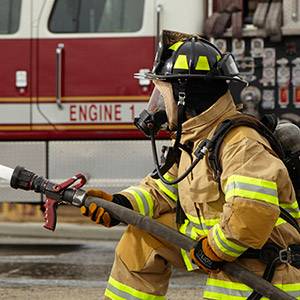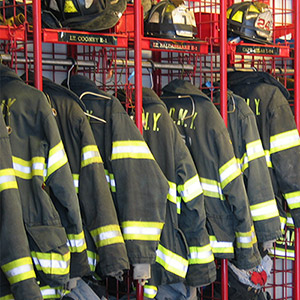Which Outer Shell Fabric is the Most Durable? The Answer is…
...it depends. It depends on who you ask and it depends on how you store and care for your turnout gear.

There are 3 primary categories of performance that all outer shells share: protection, comfort, and durability. Within these 3
categories are subsets of performance. For example, within the protection category there are factors like Thermal Protective Performance (TPP), strength after a thermal exposure, and resistance to moisture/chemical absorption. Within comfort you may consider factors like flexibility, lower weight, and higher Total Heat Loss (THL) as benchmarks for better comfort.
Then we come to durability. Within the durability category are 2 main subsets the industry considers critical to maintaining a long outer shell life: strength (tear resistance) and abrasion resistance. While this seems simple enough, it isn’t that simple.
Everyone agrees abrasion resistance is an important factor in fabric durability. The problem is no universally accepted abrasion test methods exist which accurately predict outer shell durability. The test method most commonly used to show abrasion resistance is Taber Abrasion. The problem with the Taber Abrasion test, and one reason it will never be a NFPA 1971 requirement, is that textile companies have found ways to exploit the Taber Abrasion machine. Some textile manufacturers use chemical finishes that serve to “gum up” the taber wheel…giving a false indication of the fabric’s actual abrasion resistance in the field. When you take away the tricky finishes that push taber performance to a “gummed up” 5000-6000 cycles, a fabric’s abrasion resistance has more to do with the yarns and fibers than anything else.
PBI Performance Products, Inc. states that a fabric with at least 400 Taber Abrasion cycles has enough abrasion resistance for the life of the fabric. With that in mind, all fabrics engineered with DuPont™ Nomex®/DuPont™ Kevlar® or PBI/DuPont™ Kevlar® fibers perform very well in the field. The final key to longevity against abrasion resistance in the field is to specify turnout gear with leather or polymer coated DuPont™ Kevlar® reinforcements for knees and pant cuffs. Specify fabrics with the above fibers and reinforcements to avoid most abrasion issues.
NFPA 1971 requires only a few tests that gauge the strength of a fabric in an effort to have minimum durability performance: tensile strength and tear strength. While most fabrics today have good to great tensile strength, there is more variation in the tear strength of the various outer shells.
The reason tear strength is the leading indicator of durability is because all fabrics lose strength after exposure to light (mostly UV), laundering, and normal wear and tear. Normal wear and tear includes typical firefighting activities as well as wear that comes with donning and doffing, stuffing gear in a locker, or throwing it on the truck.
The minimum tear strength for a new outer shell fabric is 22 pounds. Fabrics utilizing older technology (100 spun yarns/rip-stop design) usually have good tear strength at 40-90 lbs. Fabrics using the latest Filament Twill Technology™ have excellent tear strength at 125-250 lbs.

While turnout gear can be protected from abrasion with reinforcements on knees and cuffs, there is nothing to protect turnout gear from the sun. Sure, you can store it properly and avoid exposure to light, but eventually turnout gear will be exposed to UV, causing a loss in strength. After enough strength loss (when the fabric reaches 8 lbs. of tear strength) the fabric will tear like a piece of paper. The stronger the fabric is and the longer it takes before you can tear it by hand (8 lbs.)…the longer the gear can stay in service.
Regardless of the abrasion performance and the tear strength, if turnout gear isn’t stored and cared for properly, it won’t last nearly as long as it should. The gear that lasts the longest is the gear that is stored away from light, especially UV. That means it should be in a covered locker (tarp/drape over locker) or in a room with no UV light. The gear is also washed and inspected according to NFPA 1851 with the correct water temperatures and the correct detergents (pH levels). Think of it this way, there is a reason cars need routine check-ups and maintenance like oil changes…without them, no car will last long. The same goes for turnout gear.
